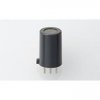Oxid uhelnatý (CO) je často nazýván "tichým zabijákem" pro jeho schopnost otrávit lidi a zvířata rychle a potichu, zatímco jeho oběti ani nevěděli, že jsou vystaveny riziku. FIS CO senzor SB-500-12 nebo kalibrovaný modul FIS3051 Vás dokážou ochránit před nebezpečnou koncentrací CO.
Toto je archivní článek z 16.05.2017. Některé informace již nemusí být aktuální a ve shodě se současným stavem. V případě pochybností Vám rádi poskytneme aktuální informace.
Stručně o oxidu uhelnatém
Oxid uhelnatý je bezbarvý, bez zápachu a chuti, ovšem vysoce jedovatý plyn. Otrava oxidem uhelnatým je nejčastějším typem smrtelné otravy v mnoha zemích. CO se s hemoglobinem (Hb) v krvi spojuje snadněji než kyslík a vytváří carboxyhemoglobin (HbCO), který není schopen přenášet kyslík pro tělesnou tkáň. Koncentrace pouze 667ppm může způsobit, že 50% hemoglobinu v krvi je přeměněno na carboxyhemoglobin. Tato koncentrace může vyústit v záchvat, kóma a smrt. V USA je organizací OHSA omezena dlouhodobá expozice na pracovišti na 50ppm. [Zdroj: Wikipedia] Koncentrace CO je měřena v ppm (Parts per Milion) nebo v mg/m3 (mg CO v 1m3 vzduchu). 1mg/m3 = 0,873 ppm.
Následující seznam shrnuje některé důsledky na zdraví při dlouhodobému vystavení různým koncentracím CO, jakož i limity doporučeně Světovou zdravotnickou organizací (WHO) a Evropskou komisí (EK).
• 8.73ppm (10mg / m3) - max. 8 hodinová průměrná koncentrace CO povolená WHO a EK.
• 26.19ppm (30mg / m3) - max. 1 hodinová průměrná koncentrace CO povolená WHO
• 100ppm - mírné bolesti hlavy za 1-2 hodiny
• 200ppm - závratě, nevolnost, únava, bolest hlavy za 2-3 hodiny.
• 400ppm - bolest hlavy a nevolnost za 1-2 hodiny. Ohrožení života za 3 hodiny.
• 800ppm - bolest hlavy, nevolnost a závratě za 45 minut, zhroucení a bezvědomí za 1 hodinu. Smrt za 2-3 hodiny.
Oxid uhelnatý je bezbarvý, bez zápachu a chuti, ovšem vysoce jedovatý plyn. Otrava oxidem uhelnatým je nejčastějším typem smrtelné otravy v mnoha zemích. CO se s hemoglobinem (Hb) v krvi spojuje snadněji než kyslík a vytváří carboxyhemoglobin (HbCO), který není schopen přenášet kyslík pro tělesnou tkáň. Koncentrace pouze 667ppm může způsobit, že 50% hemoglobinu v krvi je přeměněno na carboxyhemoglobin. Tato koncentrace může vyústit v záchvat, kóma a smrt. V USA je organizací OHSA omezena dlouhodobá expozice na pracovišti na 50ppm. [Zdroj: Wikipedia] Koncentrace CO je měřena v ppm (Parts per Milion) nebo v mg/m3 (mg CO v 1m3 vzduchu). 1mg/m3 = 0,873 ppm.
Následující seznam shrnuje některé důsledky na zdraví při dlouhodobému vystavení různým koncentracím CO, jakož i limity doporučeně Světovou zdravotnickou organizací (WHO) a Evropskou komisí (EK).
• 8.73ppm (10mg / m3) - max. 8 hodinová průměrná koncentrace CO povolená WHO a EK.
• 26.19ppm (30mg / m3) - max. 1 hodinová průměrná koncentrace CO povolená WHO
• 100ppm - mírné bolesti hlavy za 1-2 hodiny
• 200ppm - závratě, nevolnost, únava, bolest hlavy za 2-3 hodiny.
• 400ppm - bolest hlavy a nevolnost za 1-2 hodiny. Ohrožení života za 3 hodiny.
• 800ppm - bolest hlavy, nevolnost a závratě za 45 minut, zhroucení a bezvědomí za 1 hodinu. Smrt za 2-3 hodiny.
Zdroje CO
CO vzniká při nekompletním spalování paliv na bázi uhlíku (například dřevo, uhlí, olej, petrolej, benzín, nafta, zemní plyn nebo propan). Typické zdroje CO zahrnují vozidla, přenosné generátory, nástroje poháněné benzínovým motorem (například motorová pila, sekačka), požáry a výbuchy, plynové ohřívače, pece, kotle, svářečky a kouření cigaret. Cigaretový kouř obsahuje 4-6% CO (40 000 až 60 000ppm). CO se zředí v ústech a horních cestách dýchacích, ale přibližně 400ppm, které jsou vdechnuty, je stále velmi vysoká koncentrace.
CO vzniká při nekompletním spalování paliv na bázi uhlíku (například dřevo, uhlí, olej, petrolej, benzín, nafta, zemní plyn nebo propan). Typické zdroje CO zahrnují vozidla, přenosné generátory, nástroje poháněné benzínovým motorem (například motorová pila, sekačka), požáry a výbuchy, plynové ohřívače, pece, kotle, svářečky a kouření cigaret. Cigaretový kouř obsahuje 4-6% CO (40 000 až 60 000ppm). CO se zředí v ústech a horních cestách dýchacích, ale přibližně 400ppm, které jsou vdechnuty, je stále velmi vysoká koncentrace.
Jak detekovat CO
SB-500-12 je polovodičový senzor CO. Používá snímací element ve formě miniaturní (0.3x0.5mm) perly z dioxidu cínu s periodickou změnou teploty. V přítomnosti CO snímací element snižuje svůj odpor. K jeho ohřívání je použita platinová spirála. Spirála potřebuje k ohřátí snímacího elementu napětí typicky 0,9V/5s a 0,2V/20s, což se promítne do typického průměrného příkonu pouze 25 mW. Senzor je vhodný pro detekci CO v rozsahu 30 až 600ppm, což je optimální rozsah pro plynové alarmy.
Senzor sám o sobě není kalibrován. Jeho odpor kolísá od 4,5 do 40kΩ při 1000ppm CO. Výsledné zařízení musí kalibrovat jeho výrobce.
FIS také nabízí FIS3051-00NC, kalibrovaný modul se zabudovanou kompenzací teploty a vlhkosti okolí. Poskytuje alarm výstup typu 5V CMOS a otevřený kolektor.Výstup je aktivní pro koncentraci CO> 300ppm. Práh je nastaven výrobcem, ale může být změněn na požádání.
V případě zájmu o jakékoliv produkty značky FIS nás prosím kontaktujte na fis@soselectronic.com.
Nezmeškejte takové články!
Líbí se Vám naše články? Nezmeškejte už ani jeden z nich! Nemusíte se o nic starat, my zajistíme doručení až k Vám.





